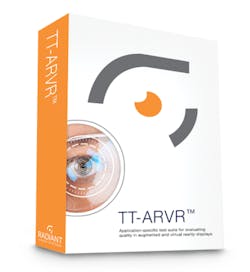TT-ARVR™ Display Test Module
Displays viewed near to the eye create immersive virtual experiences, such as those integrated into AR/VR devices. However, as display images are magnified to fill a user’s field of view (FOV), display defects are also magnified. Issues with uniformity of brightness and color, dead pixels, line defects, cloudiness, and image position become more evident to the user whose eyes are merely centimeters away from display screens.
Part of the Radiant Vision Systems TrueTest™ Software family, the TT-ARVR™ module provides all of the benefits of TrueTest Software to efficiently perform light, color, and dimensional measurements with specific tests to evaluate the quality of displays integrated into AR, VR, and MR (mixed reality) devices and headsets. A comprehensive AR/VR display test solution from Radiant combines the TT-ARVR application-specific software module, a ProMetric® Imaging Colorimeter or Photometer, and the Radiant AR/VR lens to perform rapid, automated visual inspection of AR/VR displays.
TT-ARVR uses a ProMetric imager to test all display characteristics simultaneously, capturing and processing data much faster and more consistently than a human inspector or a spot measurement device.
Comprehensive Display Test Suite
Tests for near-eye display (NED) quality include photometric measurements used to evaluate an imaged display’s light and color properties for defects and accuracy against defined tolerances. TT-ARVR allows users to define a complete set of measurement parameters and pass/fail criteria for specific points of interest on a display. The software module includes standard display tests, as well as specific tests for AR/VR quality including:
- ANSI Brightness
- ANSI Color Uniformity
- AutoPOI
- Checkerboard Contrast
- Chromaticity
- Compare POI
- Distortion 9 Point
- Distortion Dot Grid
- Distortion Line Grid Analysis
- Field View (Reports actual FOV of the display in horizontal, vertical, and diagonal)
- Focus Uniformity
- Image Export
- MTF Line Pair
- MTF LSF (Line Spread Function)
- MTF Slant Edge (based on ISO 12233)
- Particle Defects
- Pattern Mura
- Pixel Defects
- Points of Interest
- Sequential Contrast
- Uniformity
- Warping Analysis
The Field View test calculates the angular device FOV of the entire display as imaged by the system; includes horizontal, vertical, and diagonal FOV measurements.
Modulation transfer function (MTF) is calculated to determine overall image clarity. The example shows and MTF slant edge test (top) and MTF slant edge graph (bottom).
Image distortion is characterized using a Distortion Grid test pattern to measure the spatial offset between dots of the primary image (top) and a test pattern (bottom).
TT-ARVR captures dimensional measurements for projected image size and x,y position, reported in degrees (°). Software reports actual FOV of the display (horizontal, vertical, diagonal) and image position within the context of angular FOV.
Based on the TrueTest platform, any tests from the TT-ARVR test library can be added to a sequence (which are stored, so multiple sequences can be created and recalled as needed), and test parameters and pass/fail settings are input for each test. The entire sequence can be run end-to-end automatically. Individual test results are displayed and can be recorded in a report.
Multiple System Configurations
TT-ARVR can be used with a ProMetric Imaging Colorimeter or Photometer, providing multiple options to achieve the field of view, pixel resolution, dynamic range, and cost requirements for your application.
Supported by Radiant's global support staff and distributor network, TT-ARVR is field-proven and has been used to test displays in the latest high-value devices worldwide.
TT-ARVR Module Key Features and Highlights
- Quickly apply pre-defined tests for AR/VR display measurement.
- Accurate analysis of spatial data from images captured by wide-field-of-view optics.
- Software test sequencing and API device integration to control display test images in conjunction with software analyses, enabling automated production-level testing.
- Spatial x,y positions reported in degrees (°); note image position within the context of vertical and horizontal FOV.
- Data analysis functions, including bitmaps, isoplots, and cross-sections.
